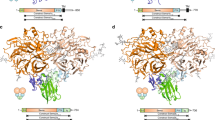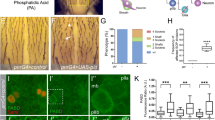Abstract
Heterotrimeric G proteins act during signal transduction in response to extracellular ligands. They are also required for spindle orientation and cell polarity during asymmetric cell division. We show here that, in Drosophila, both functions require the Gα interaction partner Ric-8. Drosophila Ric-8 is a cytoplasmic protein that binds both the GDP- and GTP-bound form of the G-protein α-subunit Gαi. In ric-8 mutants, neither Gαi nor its associated β-subunit Gβ13F are localized at the plasma membrane, which leads to their degradation in the cytosol. During asymmetric cell division, this leads to various defects: apico–basal polarity is not maintained, mitotic spindles are misoriented and the size of the two daughter cells becomes nearly equal. ric-8 mutants also have defects in gastrulation that resemble mutants in the Gα protein concertina or the extracellular ligand folded gastrulation. Our results indicate a model in which both receptor-dependent and receptor-independent G-protein functions are executed at the plasma membrane and require the Ric-8 protein.
This is a preview of subscription content, access via your institution
Access options
Subscribe to this journal
Receive 12 print issues and online access
$209.00 per year
only $17.42 per issue
Buy this article
- Purchase on Springer Link
- Instant access to full article PDF
Prices may be subject to local taxes which are calculated during checkout





Similar content being viewed by others
References
Parks, S. & Wieschaus, E. The Drosophila gastrulation gene concertina encodes a G α-like protein. Cell 64, 447–458 (1991).
Schaefer, M., Petronczki, M., Dorner, D., Forte, M. & Knoblich, J. A. Heterotrimeric G proteins direct two modes of asymmetric cell division in the Drosophila nervous system. Cell 107, 183–194 (2001).
Izumi, Y., Ohta, N., Itoh-Furuya, A., Fuse, N. & Matsuzaki, F. Differential functions of G protein and Baz-aPKC signaling pathways in Drosophila neuroblast asymmetric division. J. Cell Biol. 164, 729–738 (2004).
Costa, M., Wilson, E. T. & Wieschaus, E. A putative cell signal encoded by the folded gastrulation gene coordinates cell shape changes during Drosophila gastrulation. Cell 76, 1075–1089 (1994).
Rhyu, M.S., Jan, L. Y. & Jan, Y. N. Asymmetric distribution of numb protein during division of the sensory organ precursor cell confers distinct fates to daughter cells. Cell 76, 477–491 (1994).
Ikeshima-Kataoka, H., Skeath, J. B., Nabeshima, Y., Doe, C. Q. & Matsuzaki, F. Miranda directs Prospero to a daughter cell during Drosophila asymmetric divisions. Nature 390, 625–629 (1997).
Shen, C. P., Jan, L. Y. & Jan, Y. N. Miranda is required for the asymmetric localization of Prospero during mitosis in Drosophila. Cell 90, 449–458 (1997).
Fuse, N., Hisata, K., Katzen, A. L. & Matsuzaki, F. Heterotrimeric G proteins regulate daughter cell size asymmetry in Drosophila neuroblast divisions. Curr. Biol. 13, 947–954 (2003).
Yu, F., Cai, Y., Kaushik, R., Yang, X. & Chia, W. Distinct roles of Gαi and Gβ13F subunits of the heterotrimeric G protein complex in the mediation of Drosophila neuroblast asymmetric divisions. J. Cell Biol. 162, 623–633 (2003).
Schaefer, M., Shevchenko, A. & Knoblich, J. A. A protein complex containing Inscuteable and the Gα-binding protein Pins orients asymmetric cell divisions in Drosophila. Curr. Biol. 10, 353–362 (2000).
Parmentier, M. L. et al. Rapsynoid/Partner of Inscuteable controls asymmetric division of larval neuroblasts in Drosophila. J. Neurosci. 20, RC84 (2000).
Yu, F., Morin, X., Cai, Y., Yang, X. & Chia, W. Analysis of partner of inscuteable, a novel player of Drosophila asymmetric divisions, reveals two distinct steps in inscuteable apical localization. Cell 100, 399–409 (2000).
Cismowski, M. J. et al. Genetic screens in yeast to identify mammalian nonreceptor modulators of G-protein signaling. Nature Biotechnol. 17, 878–883 (1999).
Hampoelz, B. & Knoblich, J. A. Heterotrimeric G proteins: new tricks for an old dog. Cell 119, 453–456 (2004).
Du, Q. & Macara, I. G. Mammalian Pins is a conformational switch that links NuMA to heterotrimeric G proteins. Cell 119, 503–516 (2004).
Betschinger, J. & Knoblich, J. A. Dare to be different: asymmetric cell division in Drosophila, C. elegans and vertebrates. Curr. Biol. 14, R674–R685 (2004).
Lyczak, R., Gomes, J. E. & Bowerman, B. Heads or tails: cell polarity and axis formation in the early Caenorhabditis elegans embryo. Dev. Cell 3, 157–166 (2002).
Gotta, M. & Ahringer, J. Distinct roles for Gα and Gβγ in regulating spindle position and orientation in Caenorhabditis elegans embryos. Nature Cell Biol. 3, 297–300 (2001).
Gotta, M., Dong, Y., Peterson, Y. K., Lanier, S. M. & Ahringer, J. Asymmetrically distributed C. elegans homologs of AGS3/PINS control spindle position in the early embryo. Curr. Biol. 13, 1029–1037 (2003).
Colombo, K. et al. Translation of polarity cues into asymmetric spindle positioning in Caenorhabditis elegans embryos. Science 300, 1957–1961 (2003).
Srinivasan, D. G., Fisk, R. M., Xu, H. & Van Den Heuvel, S. A complex of LIN-5 and GPR proteins regulates G protein signaling and spindle function in C. elegans. Genes Dev. 17, 1225–1239 (2003).
Miller, K. G. & Rand, J. B. A role for RIC-8 (Synembryn) and GOA-1 (G(o)α) in regulating a subset of centrosome movements during early embryogenesis in Caenorhabditis elegans. Genetics 156, 1649–1660 (2000).
Afshar, K. et al. RIC-8 is required for GPR-1/2-dependent Gα function during asymmetric division of C. elegans embryos. Cell 119, 219–230 (2004).
Couwenbergs, C., Spilker, A. C. & Gotta, M. Control of embryonic spindle positioning and Gα activity by C. elegans RIC-8. Curr. Biol. 14, 1871–1876 (2004).
Miller, K. G., Emerson, M. D., McManus, J. R. & Rand, J. B. RIC-8 (Synembryn): a novel conserved protein that is required for G(q)α signaling in the C. elegans nervous system. Neuron 27, 289–299 (2000).
Tall, G. G., Krumins, A. M. & Gilman, A. G. Mammalian Ric-8A (Synembryn) is a heterotrimeric Gα protein guanine nucleotide exchange factor. J. Biol. Chem. 278, 8356–8362 (2003).
Kraut, R., Chia, W., Jan, L. Y., Jan, Y. N. & Knoblich, J. A. Role of inscuteable in orienting asymmetric cell divisions in Drosophila. Nature 383, 50–55 (1996).
Chen, C. A. & Manning, D. R. Regulation of G proteins by covalent modification. Oncogene 20, 1643–1652 (2001).
Farazi, T. A., Waksman, G. & Gordon, J. I. The biology and enzymology of protein N-myristoylation. J. Biol. Chem. 276, 39501–39504 (2001).
Ntwasa, M., Aapies, S., Schiffmann, D. A. & Gay, N. J. Drosophila embryos lacking N-myristoyltransferase have multiple developmental defects. Exp. Cell Res. 262, 134–144 (2001).
Takida, S. & Wedegaertner, P. B. Heterotrimer formation, together with isoprenylation, is required for plasma membrane targeting of Gβγ. J. Biol. Chem. 278, 17284–17290 (2003).
Schober, M., Schaefer, M. & Knoblich, J. A. Bazooka recruits Inscuteable to orient asymmetric cell divisions in Drosophila neuroblasts. Nature 402, 548–551 (1999).
Acknowledgements
We wish to thank J. Betschinger for comments on the manuscript; K. Afshar and P.Gonczy for sharing unpublished results; D. Dorner, M. Petronczki and M. Schaefer for generating UAS-Gβ13F, UAS-Gγ1, Myc–Gαi and Myc–GαiQL; S. Bhalerao and A. Hutterer for help with mutant analysis; and Y. N. Jan, T. Volk, the Bloomington Drosophila Stock Center and the Developmental Studies Hybridoma Bank (DSHB) for reagents. S.K.B. is supported by Boehringer Ingelheim Fonds. Work in J.A.K.'s lab is supported by the Austrian Academy of Sciences and the Austrian Research Fund (FWF).
Author information
Authors and Affiliations
Corresponding author
Ethics declarations
Competing interests
The authors declare no competing financial interests.
Supplementary information
Supplementary Information
Supplementary figure S1 and S2 (PDF 279 kb)
Rights and permissions
About this article
Cite this article
Hampoelz, B., Hoeller, O., Bowman, S. et al. Drosophila Ric-8 is essential for plasma-membrane localization of heterotrimeric G proteins. Nat Cell Biol 7, 1099–1105 (2005). https://doi.org/10.1038/ncb1318
Received:
Accepted:
Published:
Issue Date:
DOI: https://doi.org/10.1038/ncb1318
This article is cited by
-
From morphogen to morphogenesis and back
Nature (2017)
-
Prefoldin and Pins synergistically regulate asymmetric division and suppress dedifferentiation
Scientific Reports (2016)



